
The Microhylidae, commonly known as narrow-mouthed frogs, are a geographically widespread family of frogs. The 683 species are in 63 genera and 11 subfamilies, which is the largest number of genera of any frog family.

The Mantellidae are a family of the order Anura. These frogs are endemic to the islands of Madagascar and Mayotte.

Cophylinae is a subfamily of microhylid frogs endemic to Madagascar. It has over 100 species in eight genera. Members of this subfamily range from minute to fairly large, and they are highly ecologically diverse. DNA barcode research has revealed a significant taxonomic gap in this subfamily, and an estimated 70+ candidate species were identified. Many of these have subsequently been described, as well as numerous new discoveries.

Mantella are a prominent genus of aposematic frogs in the family Mantellidae, endemic to the island of Madagascar. The members of the genus are diurnal and terrestrial in behaviour, exhibiting bright colouration or cryptic markings which are species specific.

Aglyptodactylus is a genus of frogs in the family Mantellidae. These frogs, sometimes known as the Madagascar jumping frogs, are endemic to Madagascar. Systematic revisions of the groups were published in 1998 and 2015. Six species are currently recognized.
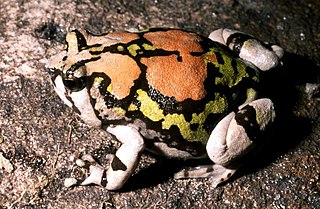
Scaphiophryne is a genus of microhylid frogs endemic to Madagascar. Some of the species are strikingly marked, while others are highly cryptic. They are rather plump and generally found on the ground. Several species in the genus are threatened because of habitat loss and overcollection for the international pet trade.

Isalo National Park is a National Park in the Ihorombe Region of Madagascar, in the southwestern corner of the Province of Fianarantsoa. The closest town is Ranohira, and the closest cities are Toliara and Ihosy. It is a sandstone landscape that has been dissected by wind and water erosion into rocky outcrops, plateaus, extensive plains and up to 200 m (660 ft) deep canyons. There are permanent rivers and streams as well as many seasonal watercourses. Elevation varies between 510 and 1,268 m.

Boophis occidentalis is a species of frog in the family Mantellidae. It is endemic to Madagascar. Its natural habitats are subtropical or tropical dry forests, rivers, pastureland, urban areas, and heavily degraded former forest. It is threatened by habitat loss.

Mantella baroni is a species of small poisonous frog in the family Mantellidae.
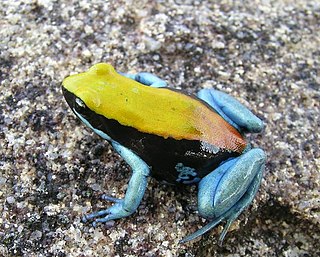
The blue-legged mantella is a small species of frog in the family Mantellidae. It is endemic to the Isalo National Park and areas south of it in Madagascar, a range it shares with the rainbow frog. Both are locally common, but endangered due to habitat loss and over-collected for the pet trade.

Mantella madagascariensis, common names Malagasy painted mantella, Madagascan mantella, Madagascar golden frog, Malagasy mantella and painted mantella, is a species of frog in the family Mantellidae.
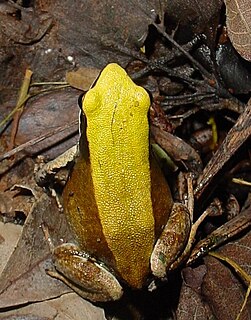
The green mantella is a species of frog in the family Mantellidae. It is endemic to Madagascar. Its natural habitats are subtropical or tropical dry forests, rivers, intermittent rivers, and heavily degraded former forest. It is threatened by habitat loss. The commercial trade in these species requires tight regulation in order not to threaten it.

Dyscophus antongilii, the Madagascar tomato frog, is a species of frog in the family Microhylidae.

Rhombophryne is a genus of microhylid frogs endemic to Madagascar. It is currently estimated to include more than 23 species, but only 20 of these are currently described. The common name 'diamond frog' has been proposed and used for members of this genus.

Scaphiophryne marmorata is a species of frog in the family Microhylidae. It is commonly known as the green burrowing frog and the marbled rain frog. It is endemic to Madagascar. It is classified as "Vulnerable" by the IUCN as it is threatened by habitat loss.
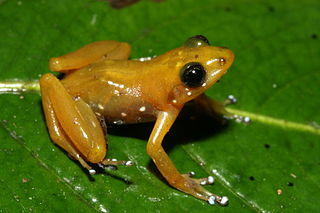
Blommersia angolafa is a species of frogs in the family Mantellidae. This recently described species is endemic to eastern Madagascar. The specific epithet is derived from the term “angolafa” or “angolafo”, which is the Malagasy vernacular name used by the Betsimisaraka people for the Dypsis palm species, whose leaves and prophylls are the habitat for this frog.

Rhombophryne serratopalpebrosa is a species of frog of the Madagascar endemic microhylid subfamily Cophylinae. Genetic evidence revealed that it is a species complex, in need of resolution. This work has made significant progress, and five related species have been described from this complex between 2014 and 2017. It is threatened by habitat loss.

Boophis ankarafensis also known as Ankarafa skeleton frog is a species of frog in the family Mantellidae. It is endemic to Madagascar's northwestern coast where it is only known from Ankarafa Forest, a forest fragment in the Sahamalaza-Iles Radama National Park.
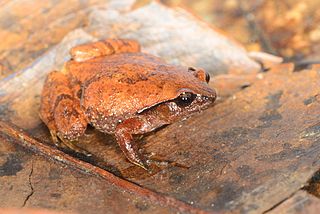
Rhombophryne botabota is a medium-sized species of frogs of the Madagascar endemic microhylid subfamily Cophylinae. It is found in the montane rainforests of northern Madagascar. It was described in 2016 from seven specimens.
Mantidactylus radaka is a species of frog in the family Mantellidae. It is endemic to Madagascar. It was described in 2020 by an international team of scientists, who differentiated it from M. guttulatus and M. grandidieri via molecular data from wild and museum specimens.






















